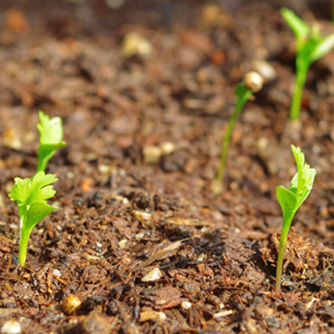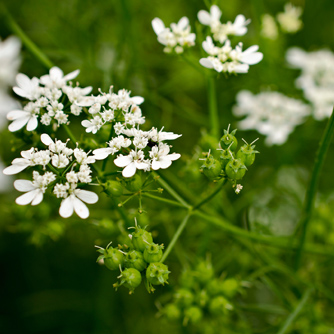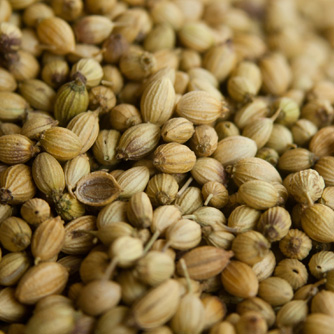Coriander
BackCoriander (Coriandrum sativum) is an annual herb that has been grown and eaten all around the world for a very long time. It has a wonderful tangy flavour and is the perfect herb for adding some zing to your cooking. Fresh leaves can be added to salads and wraps while the roots and seeds, which have a stronger flavour, are often used to enhance curries and stir fries.
If you’ve ever seen cilantro listed as an ingredient in a cookbook then they are talking about coriander leaves. American’s call the leaves cilantro and only refer to the seeds as coriander.
How To Grow Coriander
Coriander needs a sunny spot but with some protection from hot sunlight. Morning sun and light shade in the afternoon is ideal. The soil needs to be free draining and should be enriched with organic matter such as cow manure and compost. If growing in a pot choose a good quality premium potting mix.
Coriander can be purchased as seedlings or grown from seed. Sow seeds direct in the soil so there’s no need to worry about transplant shock and water in with OCP eco-seaweed to stimulate faster germination. You can also stagger successive sowings over a few weeks to extend the harvest window.

Freshly harvested coriander leaves
If starting from seedlings select small plants which have more vigor and less chance of being root bound or having experienced some other growing stress. This is important to reduce the likelihood of plants bolting. Gently plant and water in with OCP eco-seaweed to minimise transplant shock.
Ongoing plants need to be well watered and fertilised to avoid the soil drying out and to keep adequate nutrients up. A lack of water and nutrients can cause plants to bolt so water regularly and every 2-4 weeks apply a mixture of OCP eco-seaweed and OCP eco-aminogro. This will build strong healthy plants with lots of leaves to pick.
Sowing Guide for Coriander
| Growing Zone | Sowing Time |
| Cool Zones | Spring, Summer, Autumn |
| Mediterranean Zones | Spring (early), Autumn |
| Warm & Temperate Frost Free Zones | Spring (early), Autumn, Winter |
| Tropical & Subtropical Zones | Spring (early), Autumn, Winter |

Coriander seedlings emerging
Bolting
Coriander is notorious for very quickly ‘bolting’ to flower and then seed. The slightest bit of stress can see the plant switch it’s focus to flower and seed production rather than growing tasty new leaves. To minimise this action you need to:
- keep plants well watered (so no dehydration stress)
- sow seed direct so there is no transplant shock, or
- only plant young, small seedlings to minimise transplant shock
- avoid growing coriander over summer if you live in a region with hot dry summer weather
In addition there are ‘slow to bolt’ seed varieties available from online suppliers like Green Harvest and The Diggers Club. Plus there’s also the perennial long-leafed or Mexican coriander (Eryngium foetidum). While technically not coriander it has a similar flavour and can cope with warmer conditions without bolting to seed. And even though it is a perennial, in most of Australia it tends to be short lived.
If your coriander does end up bolting look on the bright side: the flowers will bring bees and beneficial insects to your garden plus you can collect the seeds to use in your cooking

Coriander flowers and developing seed heads
Harvesting Coriander
Once the plants have grown a bit, the leaves and stems can be picked at any time. Choose the outside green leaves and discard any yellowing ones. You can also pull out the entire plant and use the leaves, stems and roots. All can be crushed and chopped to add to curries or stir fries.
Once the plant has flowered and gone to seed cut off the seed heads and place in a dry environment for a couple of weeks. Many gardeners use paper bags to store the drying seed so they are protected but can still ‘breathe’ as they dry out. Once seed heads are fully dry remove the seeds and store in a sealed container. Seeds can then be used for sowing additional crops or used in cooking either whole or ground into a powder.
Pest and Diseases of Coriander
As mentioned above the most common problem with coriander is bolting to seed but there are a few other things which may occur:
- Watch out for slugs and snails on seedlings. Scatter OCP eco-shield pellets to keep them protected.
- Pick off caterpillars or read our organic caterpillar guide for more tips.
- Occasionally whitefly, aphids or mites can appear but they are easily controlled with an organic insecticide.
- Powdery mildew can attack foliage and spread quickly. Regular foliage sprays of OCP eco-seaweed and OCP eco-aminogro goes a long way to avoiding problems like this keeping the leaves strong and healthy. However if you do develop a problem then spray with an organic fungicide.

Coriander seeds


